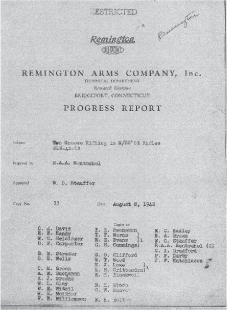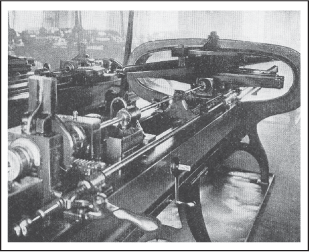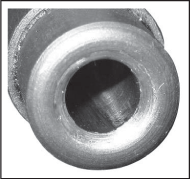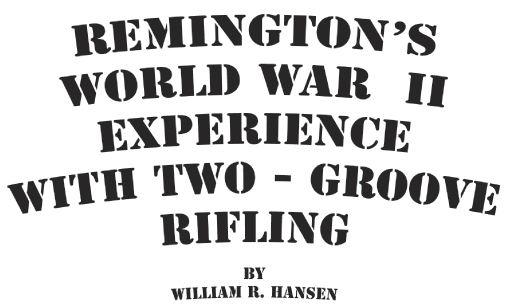
Some folks consider a record of military history merely an interesting read as a story. General George S. Patton’s view was slightly different. In his opinion, if it couldn’t be used to learn from…either correcting failed behavior or coming up with better solutions for the future, what good is it? Indeed, analytical history as a study tool takes on true relevance when we can discern useful applications for today as well as tomorrow. The following WWII story bridges both time and learning, therefore could well be classified as such an example.
On December 26, 1836, Major General Millar, Director of Artillery – British Army, said this about two-groove rifling after considerable testing of their new Brunswick P-1837 Percussion rifle:
“It was as accurate as the others at short distances and superior at long distances. There was no difficulty in handling or loading it. It shot correctly for a longer period without cleaning. The greater smoothness of the barrel made it less likely to wear away than those with projecting bearings and lands.”
| Page 24 | 2nd Quarter 2011 |
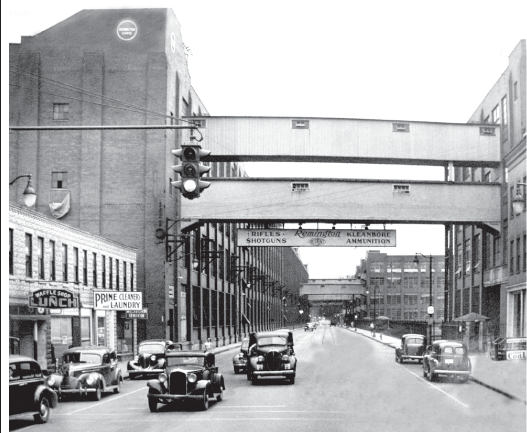
|
The British not only adopted this new rifle, but thereafter used it for almost 50 years. Moreover, theold “smoke-pole” was not soon forgotten. So, after the passing of 50-plus more years, it’s not really surprising a new generation of armorers at the Royal Arms Enfield (RSA) factory looked into the rear view mirror for answers when faced with a crisis. German bombardment during WW II’s Battle of Britain had not only wreaked havoc on British rifle making capacity, but development and production of their new and much sought after Lee-Enfield, #4, Mk.1 was behind schedule. Frantic action called for finding shortcuts to accelerate the entire process. To make a long story short, at least two of the wartime expedients for the new Enfield sent them back to the old “Brunswick”, including its flip-up rear sight and two-groove (2-groove) rifling. |
Archival material passed on to Clark Campbell for updating his fine Springfield ’03 book in 2003 essentially covers the historical genesis of British influenced reintroduction of 2-groove rifling in WWII , so won’t be repeated here. Suffice to say, the Brits introduced it through their American contract with Savage Arms Co. late in 1941. As an alternative to their standard 5-groove barrel, it was calculated that using 2-groove instead “…can release 12 or more rifling machines to other uses”, and at the same time not affect the ballistic properties of the rifle. On behalf of this foreign contract, it took less than a week for the United States (U.S.) Office of the Chief of Ordnance (OCO) to approve its use. Naturally, they wanted the contract amended to “…cover reduction in the price proportionate to amount saved by this change.” Nonetheless, OCO approval was granted almost immediately…. Spurred on by the disastrous effects of the attack on Pearl Harbor and subsequent entry of the US into the War, it didn’t take long for the Springfield Armory (SA) to be asked to examine the 2-groove prospects for U.S. made domestic small arms as well. Such manufacture |
| Page 25 | 2nd Quarter 2011 |

|
was being mobilized through commercial contracts all over the nation, and rifling simplification unquestionably would have substantial effects on the cost and rate of barrel production for everything from pistols to machine guns. Needless to say, barrel rifling was a time consuming process during this period of history. The typical hook type or “cut” rifling machines cut one groove at a time; therefore, the reduction of four grooves to two had the potential of reducing production time and cost nearly in one-half.
Here’s where the WWII story for widespread US adoption of 2-groove rifling begins to get mired down in the hide-bound persona and approach to problem-solving the SA had become very good at. The SA immediately recognized that a “one size fits all” solution wasn’t going to be a good answer for all small arms, so they began the kind of parochial dawdling that Secretary of Defense, Robert S. McNamara, would eventu- ally recognize in the 1960’s…and bring to a troublesome end. Wartime conditions or not, the SA took its accustomed posture regarding any new proposal, i.e. not wanting to proceed too hastily without a thorough review of the idea’s fundamental premises, and with joint participation of the Frankfort Arsenal (FA) and the Aberdeen Proving Ground (APG). Meanwhile, the Remington Arms Co. (RA) already had a working relationship with the Savage Plant having evolved from their development of a .303 caliber prototype of the Springfield ’03 (i.e. British Springfield, Cal. .303). In the RA’s dire view of things, time was of the essence. More critically, they recognized their Ilion plant was immersed in the same accelerated wartime rifle manufacturing business that Savage was. The British testing in May of 1941 that produced an alternate barrel approval for the Savage Arms Co. was specifi- cally aimed at rifles …not pistols, machine guns or reinvention of the wheel. So, with the permission of the OCO, Remington decided to conduct validation testing of the 2-groove barrel for use on the Springfield M1903 “Modified” then being manufac- tured at their Ilion, N.Y. plant. However, their real motivation had more to do with what already begun as rumor after “Pearl Harbor”, but soon to land them in the proverbial pressure pot. Read on…………. Remington had just recently started production of their ’03 rifle edition to augment the British need for rifles. More critically, they had come into the full realization the antiquated Springfield rifle tooling provided under lease from the Rock Island Arsenal the year before was not only old and worn, but questionably capable of manufacturing 1000 rifles a day …as led to believe. Even before “Pearl Harbor”, they remained uncertain about its true manufacturing potential. |
Nonetheless, the Japanese sneak attack suddenly changed everything. In early February 1942, the OCO asked RA to increase their ’03 production to 2000 rifles per day and a few weeks later upped it to 3000 rifles. Remington was very aware their production operation would have to radically change to meet the new mandate. Indeed, they were in the very midst of evaluating all manner of alternatives to speed up the manufacturing process when the 2-groove barrel appeared to become a very real opportunity. Barrel making shortcuts suddenly became one of their prime considerations, thus Ilion plant initiatives immediately targeted 2-groove rifling as critical to achieving their goals. Remington 2-Groove Rifle Testing 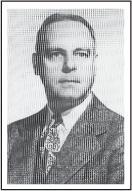 George O. Clifford Ilion Plant Manager Remington Arms Company, Inc. George O. Clifford, Ilion Plant Manager, sought approval in early February 1942 from RA headquarters in Bridgeport, Connecticut to be given the go-ahead to conduct 2- groove testing in hopes of having it approved in timely concert with studies then underway for a wide range of M1903 produc- tion shortcuts. Upon approval of the Remington front office, the task-lead was assigned the Technical Department of their Bridgeport factory under W.O. Stauffer, Manager of the Research Division. R.A. Hentschel was assigned the job in a |
| Page 26 | 2nd Quarter 2011 |
joint effort with the Ilion plant’s Industrial Engineers and their Development Section under a carefully considered protocol that would tactically involve military oversight from the Ordnance Department …deemed expedient to procedural dispatch.
regarding “…life of both the barrel and the action.” By the time the test was complete on June 20, 1942, they had enough information to more than validate the British findings.
A total of 28 rifles were involved in the validation program. All the rifles were made up of new Remington receivers pulled off the new M1903 “Modified” assembly line except for one Springfield, as further explained below. The 27 Remington receivers were then built-up with new 2-groove barrels and assembled into rifles with all new parts for 100 yard accuracy testing. However, 3 of the rifles were arbitrarily selected for additional controlled trials at 100, 200 and 600 yards with one of the 3 selected for the endur- ance firing of 16,000 rounds. It is interesting to note that all 100 yard shooting was done indoors using a standard elbow and muzzle rest, while the 200 and 600 yard testing was conducted outdoors using the prone position.
|
As noted above, two of the three rifles selected for the special supplemental trials were new Remington ’03 receivers equipped with new 2-groove barrels. Their serial numbers (SN) were 3030030 and 3030571, respectively, thus indicating approximate receiver manufacture in the first or second week of February 1942. The 3rd rifle was a standard 4-groove SA made Springfield rifle, SN 1283325, designated as the trial-comparison rifle. The new 2-groove barrels being tested were manufactured using standard rifling machines, but each had to be indexed by hand in order to cut only two opposing grooves at 180 degrees separation in lieu of the standard four. In other words, the indexing mechanism on the rifling machine had to be modified since it was inherently designed to travel through 90 degrees, not 180. The 2-groove rifling was carefully gauged for all 27 guns and each met the standard dimensional tolerance allowances for the Springfield M1903 without changing the width or depth of the grooves, as follows: Width of groove: Essentially, the 2- groove barrel configura- tion was identical to the standard 4-groove barrel, except for omission of two opposing grooves. Note: Also see Figure 1, on next page. |
| Page 27 | 2nd Quarter 2011 |
|
Testing & Results All 28 guns were initially fired at 100 yards and without any problem. Each passed the Ordnance accuracy standards calling for 5 shots to strike within a three (3) inch circle. The resultant report concluded: “No difference in accuracy was noted between these guns and regular production.” Subsequently, the three guns commissioned at random for supplemental testing were subjected to the distance and endurance testing. The final accuracy test results are shown in Table 1 below for the three principal test guns only, and will constitute the primary focus of this article in the interests of brevity. It is noted that Remington SN 3030030 was tested first at 100 |
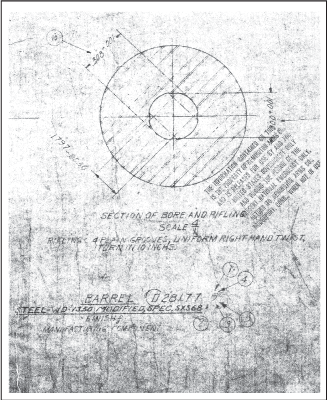 |
yards in April before the decision was made to alter the overall trial protocol in order to advance the more time consuming 16,000 round endurance test. A part of that decision was also to employ one of the 2- groove rifles for distance testing AFTER completion of the endurance test. Remington SN 3030571 had been selected for this latter trial, which was finally completed on June 16th. Thereafter, completion of the firing test program was resumed with the other two rifles, including the 200 and 600-yard distances.
All firing was performed by three designated marksmen from the Ordnance Department under conditions permitting objec- tive validation of the results. For example, Mr. Hall was the only marksman used for each of the three rifles at the 100-yard distance in order to satisfy a
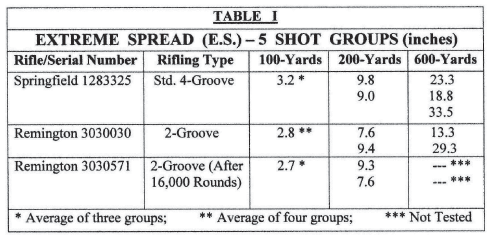
| Page 28 | 2nd Quarter 2011 |
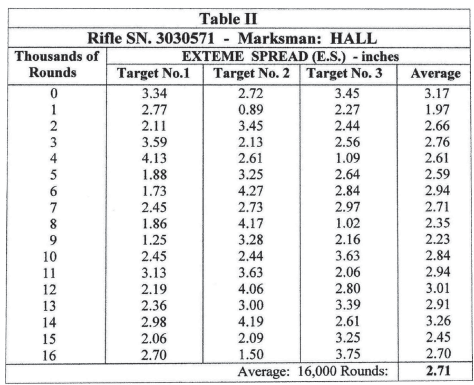
|
uniformity/equivalency baseline comparison between each rifle. However, for the 200 and 600-yard ranges, two shooters (Mr. Fisher and George Parker) were used to also address possible anomalies related to inconsistency factors inherent in each rifle separately. In only one instance was a rifleman allowed a second chance… and that was for the test firing of Springfield SN 1283325 at 600 yards. In that particular case, Parker’s first attempt was deemed “problematic”; therefore, he was granted a second attempt. More will be said about that later.
As shown by the results at 100 and 200 yards (Table 1), the 2-groove barrel out-performed the 4-groove edition by a notable margin. Even at the 600- yard distance, where the average scores were approximately the same, the 2- groove barrel achieved the better technical performance. However, it is also noted that Remington SN 3030571 did not fire at the 600-yard range. It was learned during the sighting-in process that the rear sight was not behaving properly. So, rather than start over with another rifle, it was decided to dispense with using it at all in the interests of time for the 600-yard test. By then, the validation-testing program was in the 3rd week of June and Remington management becoming anxious for results and closure. It is also speculated that the rear sight difficulties may well have had something to do with the fact that SN 3030571 was used for the 16,000 round endurance trials started in April and continuing into June 1942. |
In this author’s opinion, the 16,000 round endurance test phase of the overall effort revealed an astonishing testimony about Remington’s 2-groove rifling barrel that is still being extolled by modern day shooters. As part of the endurance test, SN 3030571 was also shot for 100-yard accuracy every 1000 rounds. Once again, an Ordnance representative carried out this particular test. Indeed, for this prolonged firing spree over 3 different targets, Mr. Hall was assigned the task as rifleman. The test protocol called for taking “Extreme Spread” (ES) measurements for each of the targets after 1000 rounds, then averaging them both for each target as well as overall ES. The results of the test are in Table II below. As evident from the Table, the grand average ES after 16,000 rounds was 2.71 inches with the lowest at 1.97 inches…using |
| Page 29 | 2nd Quarter 2011 |
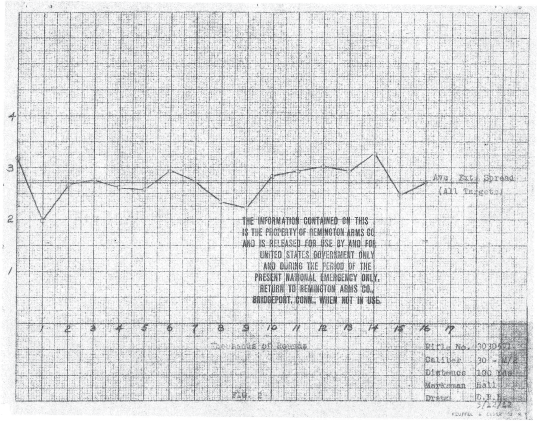
Figure 2: 16,000 Round Endurance Test – Accuracy Variance Graph
|
an “elbow and muzzle rest”. The highest ES was 3.17 inches, experienced at the very beginning when the barrel was still new after sighting-in. The related graph plot shown in Figure 2 below is very revealing inasmuch as it depicts the variance both above and below the 2.71 inch overall average axis (plus and minus ordinate measure- ments) was not only markedly balanced, i.e. evenly distributed throughout the 16,000 fired rounds, but revealed no detectable indications of accuracy change throughout the course of the trial.
Remington and Ordnance also learned some other things from the endurance test that proved ominous, but not fatal. After completion of the endurance test, “…the barrel showed bad heat checking at the breech end when examined with a Borescope.” They also observed streaks of metal fouling along the length of the barrel. Nevertheless, when the change in the groove and land diameter tests were reviewed, the differences found were judged insignificant since “…they were within the experimental error of the method used.” George Parker from Ordnance was responsible for conducting this phase of the laboratory analysis using sulfur casts taken at the end of each 5000 round stage, and again after completion of firing the 16,000 rounds. In every case, the differences were found to be substantially within a one ten-thousand range. |
The summary results of the 100, 200 and 600-yard tests are shown in below. It is noted that whereas the Springfield comparison rifle results were based on only 3 different 5-shot groups, the Remington 2-groove rifle selected at random (SN 3030030) was extended to an average from 4 different groups. Nonetheless, the 2-Groove barrel appeared considerably more accurate at both the 100 and 200-yard distances. At 600-yards, they were judged essentially equivalent. However, it is pointed out that marksman Parker was having accuracy problems with every rifle fired at the 600-yard distance. In this writer’s opinion, the most amazing observation was the performance outcome of Remington 2-Groove, SN 3030571. This particular rifle had already gone through a grueling 16,000 round endurance test, but when it was also re- tested thereafter for the 100, 200 and 600-yard distances, its performance was marginally superior to both the other two rifles! |
| Page 30 | 2nd Quarter 2011 |
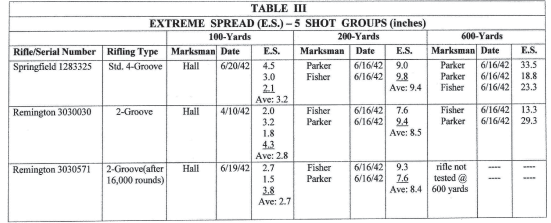
|
Pressure and Velocity Results of the pressure and velocity tests also proved interesting. Personnel from the Physics Section at RA’s Bridgeport laboratory performed all measurements. The protocol for the test required measurements for both the 2 and 4-groove barrels before and after fitting of pressure pistons. One barrel of each type was selected at random with testing of two types of ammunition, both ball and armor piercing. In the interests of article brevity, the tabulated results are not being shown; however, the bottom-line was this: using stan- dard “ball†ammo, both rifling types showed substantially identical results with velocities in the 2-groove about 50 fps slower and pressure slightly higher. While these results were reasonably expected as characteristic differences endemic to the nature of the two rifling systems, in both cases, the differences were well within “error of measure- ment†standards.
However, the use of armor piercing ammo presented noticeably different pressure results. The 2-groove barrel revealed a pressure increase consistently in the 3000 to 4000-psi range, with slightly decreased velocities. However, the final report concluded this to also be “…not particularly significant.†Indeed, while emphasizing that only one 2-groove barrel had been tested for armor piercing ammunition, no further tests were deemed necessary for two reasons: (1) The elevated pressure was not considered serious, and (2) “…armor piercing ammunition is seldom used in the Springfield rifle.” |
As stated previously, Remington’s 2-groove testing under the auspices of Ordnance participation and oversight was completed on June 20, 1942. The final report findings were simply stated: “On the basis of tests made to date, the two groove rifling equals the standard four groove rifling in performance.†The results were formally turned over to the Ordnance Department by letter from Remington’s L.R. Crittenden to Lt. W.J. Bertsche on June 23, 1942. It is noted that Bertsche was the onsite Army Inspector of Ordnance stationed at the Ilion plant at the time. Remington advised Remington 2 –Groove Barrel that if any further testing were desired, they’d be glad to do it. However, they were anxious for a prompt approval for using 2-groove rifling, hopefully as quickly as the one Savage had re- ceived. But, it didn’t happen! Wartime Bureaucracy As intimated in this article’s Introduction, the Springfield Armory (SA) often marched to a different drummer. While Lt. Bertsche of the Ordnance Department may have received the Remington report in June in time for an easy turn-around approval to convert to -groove barrel- making at the start of the M1903A3 program, the report went without action. Indeed, it wasn’t to be acknowledged by the SA until 4 months later after RA officially represented it on August 8, 1942, as discussed further below. By then, the ‘A3 program was well on its way to initial production. Had it not been for complications with significant rear sight corrections, full M1903A3 production would have begun in October. But, even then…the 2-groove barrel was still not approved. What happened? It is simply this. The OCO was reluctant to routinely approve anything without the official blessing of the Springfield Armory and its institutional relationship tethered to both the FA and the APG. The SA didn’t happen to regard rifles as having any particular priority or urgency at that point in time over other 2-groove testing applications. |
| Page 31 | 2nd Quarter 2011 |
Therefore, the RA found itself having to await their systematic review process for a blanket request addressing all small arms. Furthermore, any properly conducted investigation by SA routine necessarily had to include an evaluation of other alternatives that might represent a better solution than 2- groove rifling. This was simply the SA way.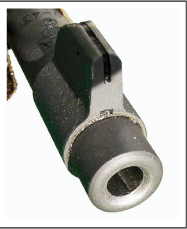 New-in-wrap Remington 2-groove rifle barrel Early on, the SA initiated its assignment response with a conven- tional request to the British Purchasing Commission (BPC) for copies of the British testing program. From the material received, they learned the British were failing to recommend 2- groove rifling for their .303 machine gun barrels “…on account of pronounced tendency for this rifling to break up incendiary tracer bullets.†Even though later found not to be a problem in US made M2 (machine gun) barrels, it managed to help set the stage for everything to follow. Indeed, early on…SA’s Col. Walter T. Gorton in a letter to the OCO dated 2 February 1942, said: “I think it would be smart to ask A.P.G. and F.A. for opinion before we fool around too much.†Needless to say, the months passed by without any formal response to the Remington testing program or request for approval to authorize 2-groove rifling. Meanwhile, SA and company had pretty much stone-walled themselves into a fundamental challenge of the British findings, in spite of a March 1942 interim report to the OCO admitting “…2-groove rifling as per previous endorsements are encouraging.†But, they weren’t persuaded since they believed that an odd number of barrel grooves would provide a superior alternative. In June the OCO would ask them to hold off further testing of 3-groove rifling tests “…pending completion of test of 2-groove rifling now being conducted at the APG.†It didn’t seem to matter. The SA would stand firm in their belief that any changes to the standard 4-groove rifling requires sufficient pre-testing that embraced: (1) 3-grooves or some other odd number as “…a sounder approach than a reduction in the number of grooves from 4 to 2â€; (2) adding increased and/or decreased groove depth as part of any testing program; and (3) in the case of 2- groove, it would be better to use “rifling of the reverse form, i.e., wide grooves and narrow lands†in lieu of merely remov- ing two of the grooves on a 4-groove machine. Furthermore, they strongly believed that any such testing should be prop- erly “…studied at Aberdeen and Frankford Arsenal†before adoption. They even sought to impose their influence on commercial barrel-making vendors under contract. For example, by letter of August 18, 1942, the SA advised the Winchester Repeating Arms Co. of their opposition to 2-Groove rifling for the M1 .30 cal. rifle barrels in spite of the fact that 2-groove rifle barrels for the M1 were then showing promise. They had also cajoled the Auto-Ordnance Corporation into spending their |
own funds to experiment with differing types of .45-caliber rifling as opposed to just dealing with the 2-groove option.
Meanwhile, RA was becoming concerned the SA may have lost all appreciation for their obvious assignment objective, particularly as related to rifles. The central question was determining the efficacy of using 2-groove rifling as a “wartime The Ordnance Technical Committee found that:
Timely OCO intervention from the “Pentagon†was inevi- table. Thus, the Chief of the Technical Division of the OCO, Brig. Gen. G.M. Barnes, got involved among others, resulting in the “Sub-Committee on Small Arms†review of the summary tables and star gage records of 16 two-groove barrels tested by the APG. Their response was immediate. With no further delay, they sent the Ordnance Technical Committee a formal recommendation on October 15, 1942 to adopt 2-groove rifling…all while referring back to the fundamental premise in the first place, which was to reduce wartime costs and speed up production as determined by the British findings. The Ordnance Technical Committee report even made reference to the APG’s use of RA’s M1903A3 rifles in the test, thus proving for the record that ‘A3 production was already underway at Remington Arms in October 1942. Further- more, the approval was applicable to only the “rifles†then being used by the services, i.e. the M1, 1903A1, 1903A3 and M1917. |
| Page 32 | 2nd Quarter 2011 |
|
Epilogue Subsequently, 2-groove rifling went on to be approved for manufacture, the story of which is summarized in Clark Campbell’s fine book. On October 23, 1942 the OCO ordered, with the SA following up on November 3rd, that all affected barrel drawings be revised to show 2-groove rifling as an option/alternative to 4-groove. The debate was to go on for a couple more months about how to handle barrel-makers using the “broach- ing†method of rifling, as well as dealing with SA ini- tiatives for further increasing bore and rifling toler- ances. But, eventually RA’s Ilion Plant was finally able to mobilize for the conversion over to 2-groove rifling in January 1943, the barrels of which began showing up on assembled rifles a few months later. Needless to say, they had already “…devised a method of changing over rifling machines from a 4-groove index to a 2-groove.†But, it wasn’t until March 6, 1943…some 9 months after initiating their approval request for 2-groove rifling option, that the SA finally forwarded a marked print of the ‘03A3 barrel to the OCO for approval showing 4-grooves standard and 2-grooves as an alternate. (Revision 6, dated 3-1-43, drwg. No. D44077). |
Meanwhile, the SA still wasn’t about to give up on their 3-groove rifling posture. On December 17th, they shipped a 3-groove M1 rifle “…to the Winchester Company for examination and such experimental firing as it is desired to make.†They persisted in their firm belief that a “…three-grooved barrel is more practicable for fabrication and much less objectionable bal- listically than the two-grooved barrel proposed by the Office of the Chief of Ordnance†(underlining added). In spite of what appears to be insubordina- tion towards their front office, the SA would eventually be silenced on the subject. This was not only a wartime situation, but one has to wonder if this typified the “bureaucratic infighting†referred to by Defense Secretary McNamara 20 years later helping him justify the merciful retirement of the Springfield Armory to a well-earned place in US history. Indeed, when put into the “cause & effect†or “critique & consequence†study of analytical history, the RSA Enfield factory, Secretary McNamara and General George S. Patton may have had a lot more in common than most folks have given much thought. In closing, it is also interesting that the Remington Arms Co. began experimenting in December 1942 with development of “draw rifling†for 03- A3 barrel manufacture. This methodology of “…using a pushing action on a plug to rifle a barrel†was eventually perfected by War’s end and the subject of a future article. Indeed, over 35,000 M1903A3 barrels were rifled by this process and accepted by the Ordnance Department. |
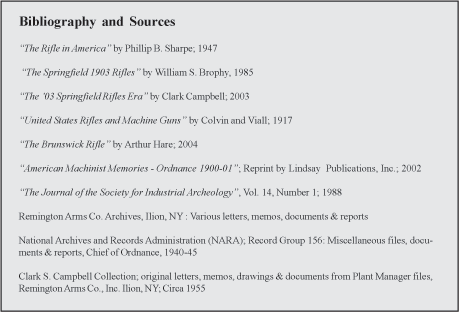
| Page 33 | 2nd Quarter 2011 |
| On-line Search/Sort Journal Index |
On-line Journal Articles New Journals have links to
|

